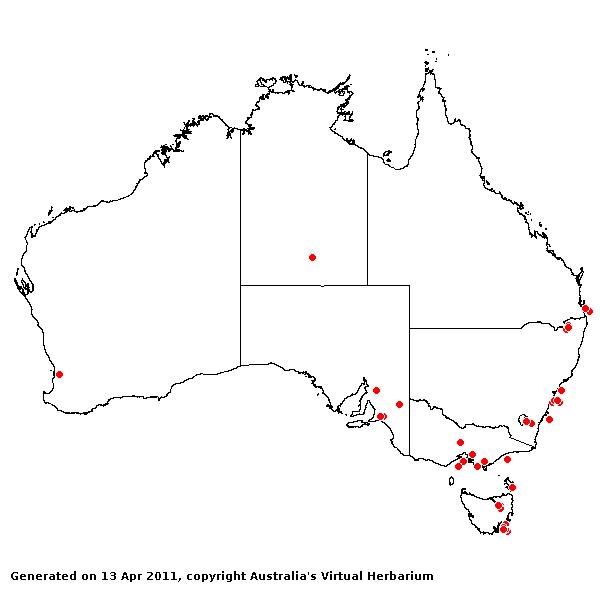Cortaderia selloana* (Schult.) Aschers.
& Graebn. Gard. Chron. ser. 3, 22: 387 (1897).
Classification. (GPWG 2001) : Subfamily Danthonioideae. Tribe
Danthonieae.
Basionym and/or
Replacement Name: Arundo selloana
Schult. & Schult. f. Mantissa 3(Add. 1): 605 (1827).
Type of Basionym or
Protologue Information: Brazil:
Brasilia, F.
Sellow 316 (HT: B).
Recent synonyms:
C. argentea.
Key references (books
and floras): [1952] C.A.Gardner, Flora of Western Australia 1 Gramineae
(131 as C. argentea), [2002] D.Sharp & B.K.Simon, AusGrass,
Grasses of Australia, [2002] J.Wheeler, N.Marchant & M.Lewington, Flora
of the South West (408), [2006] J.Jessop, G.R.M.Dashorst, F.M.James, Grasses
of South Australia (299), [2008] S.W.L.Jacobs, R.D.B.Walley &
D.J.B.Wheeler, Grasses of New South Wales (189).
Illustrations:
[2006] J.Jessop, G.R.M.Dashorst, F.M.James, Grasses of South Australia (298, fig. 235), [1984] N.T.Burbidge. rev.
S.W.L.Jacobs, Australian Grasses (93), [2008] S.W.L.Jacobs, R.D.B.Whalley &
D.J.B.Wheeler, Grasses of New South Wales, 4th edn (189).
Habit.
Perennial. Culms 100–400 cm tall. Mid-culm internodes hollow. Ligule a fringe
of hairs, 3–5 mm long. Leaf-blades 60–200 cm long, 3–15 mm wide.
Inflorescence.
Inflorescence compound, a panicle. Panicle ovate, dense, 25–100 cm long.
Spikelets.
Spikelets pedicelled. Male spikelets pedicelled. Fertile spikelets many
flowered, with at least 2 fertile florets, comprising 3–7 fertile floret(s),
with diminished florets at the apex, lanceolate, laterally compressed, 10–18 mm
long.
Glumes. Glumes
similar, similar to fertile lemma in texture, shiny. Lower glume lanceolate,
hyaline, without keels, 1 -nerved. Upper glume lanceolate, 8–14 mm long,
hyaline, without keels, 1 -nerved. Florets. Fertile florets female.
Fertile lemma 9–18 mm
long, without keel, 3 -nerved. Lemma surface indumented. Lemma apex muticous.
Palea 2 -nerved. Lodicules present.
Continental
Distribution: Europe, Africa, Temperate Asia, Tropical Asia, Australasia,
Pacific, North America, and South America.
Australian
Distribution: Western Australia, South Australia, Queensland,
New South Wales, Victoria, Tasmania.
Western
Australia: Drummond, Dale, Menzies, Warren. South
Australia: Eyre Peninsula, Northern Lofty, Murray, Southern Lofty. Queensland:
Darling Downs, Moreton. New
South Wales: Central
Coast. Victoria:
Gippsland Plain, Midlands. Tasmania: No region given.
Notes.
Dried specimens are very similar to C. jubata, but it can be
distinguished by the presence of male plants, by the unequal glumes and the
lemmas with grey veins with only the central vein reaching the apex of the
lemma.
Widespread
in Australia, mostly in
disturbed sites, introduced from South America,
a world-wide escape from horticulture. Flowers March to Sep.





